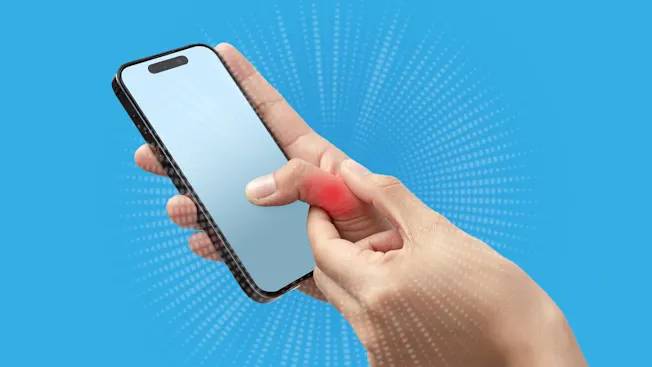What Is Smartphone Thumb?
“Smartphone thumb” is a modern health concern affecting people of all ages due to the frequent use of mobile phones. It occurs when the tendon that allows your thumb to bend and move becomes inflamed from repetitive motion. This inflammation can lead to pain, stiffness, and reduced thumb mobility.
In earlier times, similar tendon problems were often seen in factory workers or skilled laborers who performed repetitive tasks for long hours. Today, with the widespread use of smartphones, constant texting, scrolling, and typing have replaced those repetitive industrial movements—leading to the same kind of strain on the thumb joint.
Why Does It Happen?
The thumb is not designed for continuous, repetitive movements like typing messages or holding large phones for long periods. Overuse places excess pressure on the tendons and surrounding tissues, which may lead to inflammation, discomfort, or even long-term issues such as tendonitis. The constant bending and flexing motion while texting or browsing contribute to this strain, especially when done with one hand.
Common Signs of Smartphone Thumb
If you experience any of the following symptoms, you might be developing smartphone thumb:
- Pain or stiffness in the thumb joint
- Swelling or tenderness at the base of the thumb
- Difficulty gripping objects or holding your phone
- A snapping or popping feeling when moving the thumb
How to Prevent Smartphone Thumb
1. Take Regular Breaks
Avoid holding your smartphone for long, uninterrupted periods. Set reminders to take short breaks from your device every 20–30 minutes. Let your hands and fingers rest to reduce strain.
2. Use Voice Commands and Speech-to-Text
Modern smartphones come with voice-to-text and virtual assistant features. Using these tools can minimize the need for repetitive thumb movements, giving your hands a much-needed rest.
3. Try a Stylus
Using a stylus can be an excellent alternative to direct finger typing. Once you get used to it, you’ll find it both comfortable and convenient. This method also reduces the constant pressure on your thumbs.
4. Switch Hands Frequently
Avoid using only one hand to text or scroll. Switching hands from time to time helps distribute the strain evenly across both hands and prevents overuse of one thumb.
5. Place Your Phone on a Surface
Instead of holding your phone in your hands all the time, try placing it on a table or desk while typing. This position allows you to use multiple fingers rather than relying solely on your thumbs, which lessens the pressure on the tendons.
Final Thoughts
Smartphone thumb might seem like a minor issue at first, but it can cause long-term discomfort if ignored. Being mindful of your hand posture and giving your thumbs regular rest can help prevent this problem. Incorporating small changes in your smartphone habits today can protect your hand health for years to come.
Always consult with your doctor or a healthcare professional before making any major changes to your diet, lifestyle, or medical routine. They can offer personalized advice based on your current health condition and medical history.
Note – If you have any health-related concerns, please call us at +91-9058577992 to receive free consultation from our experienced doctors. Thank you.
